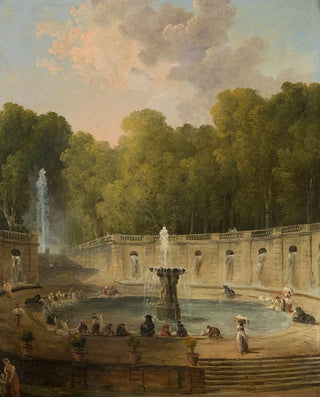Art print | Laundresses in a Park - Hubert Robert


View from behind

Frame (optional)
Lavandières in a park - Hubert Robert – Captivating Introduction
In the artwork "Lavandières in a park," Hubert Robert transports us to a universe where nature harmoniously blends with scenes of everyday life. This canvas, imbued with serenity and poetry, reveals an idyllic vision of rural life, where women are busy washing laundry by the riverbank, under the watchful gaze of majestic trees. The soft light and pastel colors create a soothing atmosphere, inviting the viewer to contemplate this scene with wonder. Robert, a true master of composition, manages to capture the fleeting moment of a mundane activity, transforming it into a timeless art print.
Style and uniqueness of the work
Hubert Robert's style is distinguished by his ability to blend realism and romanticism, offering a vision that is both faithful and beautified of nature. "Lavandières in a park" perfectly illustrates this duality. The female figures, although depicted with great attention to detail, are idealized, almost ethereal. Their delicate gestures and interaction with the environment demonstrate harmony between man and nature. The trees in the background seem to lean towards the laundresses, as if to protect them from the heat of the sun. This compositional choice, where each element finds its place, reveals the artist's skill in orchestrating a lively tableau, where light and shadow dance together to create striking depth. The subtle nuances of greens and blues reinforce this impression of tranquility, while the white touches of laundry add a note of freshness to the overall scene.
The artist and his influence
Hubert Robert, often considered the painter of ruins and landscapes, left his mark on his era with his unique vision of the world. Born in Paris in 1733, he was part of the neoclassical movement, while incorporating elements of baroque and romanticism. His career, marked by success, allowed him to explore various genres, ranging from landscapes to historical scenes. Robert's influence is felt not only among his contemporaries but also in subsequent generations. His innovative approach to light and composition paved the way for many artists, who

Matte finish

View from behind

Frame (optional)
Lavandières in a park - Hubert Robert – Captivating Introduction
In the artwork "Lavandières in a park," Hubert Robert transports us to a universe where nature harmoniously blends with scenes of everyday life. This canvas, imbued with serenity and poetry, reveals an idyllic vision of rural life, where women are busy washing laundry by the riverbank, under the watchful gaze of majestic trees. The soft light and pastel colors create a soothing atmosphere, inviting the viewer to contemplate this scene with wonder. Robert, a true master of composition, manages to capture the fleeting moment of a mundane activity, transforming it into a timeless art print.
Style and uniqueness of the work
Hubert Robert's style is distinguished by his ability to blend realism and romanticism, offering a vision that is both faithful and beautified of nature. "Lavandières in a park" perfectly illustrates this duality. The female figures, although depicted with great attention to detail, are idealized, almost ethereal. Their delicate gestures and interaction with the environment demonstrate harmony between man and nature. The trees in the background seem to lean towards the laundresses, as if to protect them from the heat of the sun. This compositional choice, where each element finds its place, reveals the artist's skill in orchestrating a lively tableau, where light and shadow dance together to create striking depth. The subtle nuances of greens and blues reinforce this impression of tranquility, while the white touches of laundry add a note of freshness to the overall scene.
The artist and his influence
Hubert Robert, often considered the painter of ruins and landscapes, left his mark on his era with his unique vision of the world. Born in Paris in 1733, he was part of the neoclassical movement, while incorporating elements of baroque and romanticism. His career, marked by success, allowed him to explore various genres, ranging from landscapes to historical scenes. Robert's influence is felt not only among his contemporaries but also in subsequent generations. His innovative approach to light and composition paved the way for many artists, who






